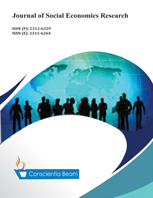Determining Rural Poverty in Manga Del Cura – Ecuador Non Delimited Zone
DOI:
https://doi.org/10.18488/journal.35/2016.3.1/35.1.13.20Abstract
This paper shows the implementation of the direct method, also called unsatisfied basic need index, indirect or poverty line method, Gini coefficient and Lorenz curve in Manga del Cura non delimited zone in Ecuador. The data used are the result of the processing of questionnaires applied to the people living in the zone. Simple probabilistic randomized sampling was applied for data processing (136 questionnaires). Housing and minimum equipment for home were analyzed, together with infrastructure, access to education and home subsistence ability. Results show that residents have more than one unsatisfied basic need, among them overcrowding, in an infrastructure that does not guarantee the minimum sanitary standards needed. These people live under the line of poverty because their average earnings correspond to 271, 37 USD, not enough to cover the cost of a basic food basket and Ecuadorian vital food basket. Engel and Gini coefficients demonstrate that there is equity in income distribution, what does not necessarily constitutes an indicator of good economic conditions, on the contrary, in this particular case, they indicate that this population group has similar, under 300.00 USD, monthly incomes.

